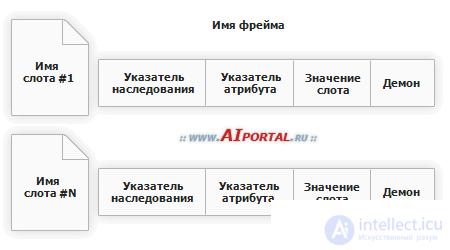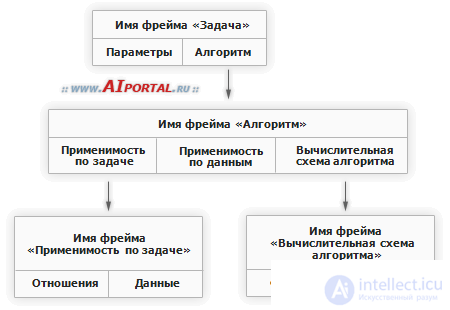The frame model is based on the concept of Marvin Minsky (Marvin Minsky) - professor at the Massachusetts Institute of Technology, founder of the laboratory of artificial intelligence, the author of a number of fundamental works. The frame model is a systematic psychological model of human memory and consciousness.
Frame (eng. Frame - frame, frame) - a data structure for representing a certain conceptual object. Information relating to the frame is contained in its constituent slots.
A slot (an English slot is a slot, a slot) can be a terminal (hierarchy sheet) or be a lower level frame.
Each frame, as shown in the figure below, consists of an arbitrary number of slots, some of which are usually determined by the system itself to perform specific functions, and the rest are determined by the user.
Explanation:
- frame name ( frame name) is the identifier assigned to the frame. The frame must have a name that is unique in this frame model (a unique name);
- slot name ( slot name) is the identifier assigned to the slot. The slot must have a unique name in the frame to which it belongs. Usually, the name of a slot does not carry any meaning and is only an identifier of this slot, but in some cases it may have a specific meaning;
- inheritance index - only for frame models of a hierarchical type; they show what information about the slots attributes in the top-level frame is inherited by slots with the same names in the lower-level frame;
- attribute pointer - slot data type pointer. These types include:
 (pointer),
(pointer),  (whole),
(whole),  (real)
(real)  (boolean),
(boolean),  (attached procedure)
(attached procedure)  (text),
(text),  (list),
(list),  (table),
(table),  (expression) and others;
(expression) and others;
- slot value - the value corresponding to the slot data type and satisfying the inheritance conditions;
- daemon - a procedure that automatically starts when a certain condition is met. Demons are launched when accessing a particular slot of the frame model. For example, demon
 it is launched if at the moment of accessing the slot its value was not set,
it is launched if at the moment of accessing the slot its value was not set,  starts when values are inserted into the slot,
starts when values are inserted into the slot,  starts when the slot value is erased.
starts when the slot value is erased.
An example of a frame model of a hierarchical type is shown in the figure below:
Frames form a hierarchy. The hierarchy in frame models generates a single multi-level structure that describes either an object, if slots describe only the properties of an object, or a situation or process, if individual slots are names of procedures attached to a frame and called when it is updated.
Formally, a frame is a data type of the form:
 - the name of the object;
- the name of the object; - a set of slots containing facts defining the declarative semantics of the frame;
- a set of slots containing facts defining the declarative semantics of the frame; - many slots that provide links to other frames (causal, semantic, etc.);
- many slots that provide links to other frames (causal, semantic, etc.); - many slots that provide transformations that define the procedural semantics of the frame.
- many slots that provide transformations that define the procedural semantics of the frame.
Frames are divided into:
- frame instance is a concrete implementation of the frame describing the current state in the subject area;
- frame sample - a template for describing objects or allowable situations in the domain;
- frame class is a top-level frame for representing a set of sample frames.
The composition of frames and slots in each specific frame model may be different, but within a single system it is advisable to have a single view to eliminate unnecessary complications.
Different types of objects or objects corresponding to the concept of “multiplicity of worlds”, which consists, for example, that a horse is a wingless animal for one (real) world and at the same time winged (Pegasus in the mythical world) for another, can be described with different frames .
In general, the frame model allows the presentation of all properties of declarative and procedural knowledge. The nesting depth of slots in a frame (the number of levels) depends on the subject area and the language that implements the model.

 (pointer),
(pointer),  (whole),
(whole),  (real)
(real)  (boolean),
(boolean),  (attached procedure)
(attached procedure)  (text),
(text),  (list),
(list),  (table),
(table),  (expression) and others;
(expression) and others; it is launched if at the moment of accessing the slot its value was not set,
it is launched if at the moment of accessing the slot its value was not set,  starts when values are inserted into the slot,
starts when values are inserted into the slot,  starts when the slot value is erased.
starts when the slot value is erased.

 - the name of the object;
- the name of the object; - a set of slots containing facts defining the declarative semantics of the frame;
- a set of slots containing facts defining the declarative semantics of the frame; - many slots that provide links to other frames (causal, semantic, etc.);
- many slots that provide links to other frames (causal, semantic, etc.); - many slots that provide transformations that define the procedural semantics of the frame.
- many slots that provide transformations that define the procedural semantics of the frame.
Comments
To leave a comment
Knowledge Representation Models
Terms: Knowledge Representation Models